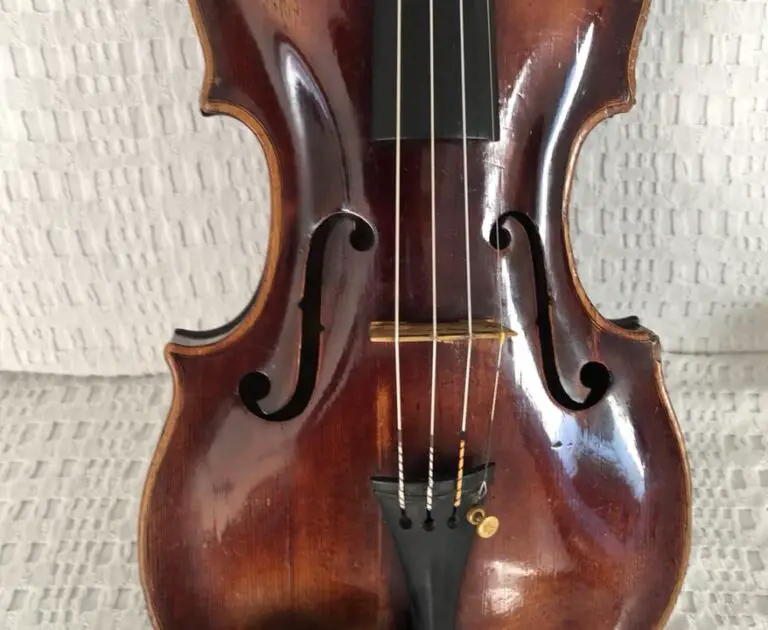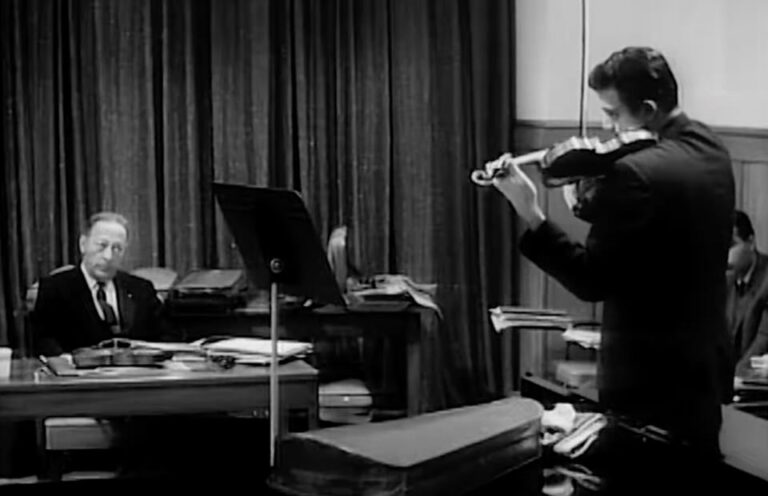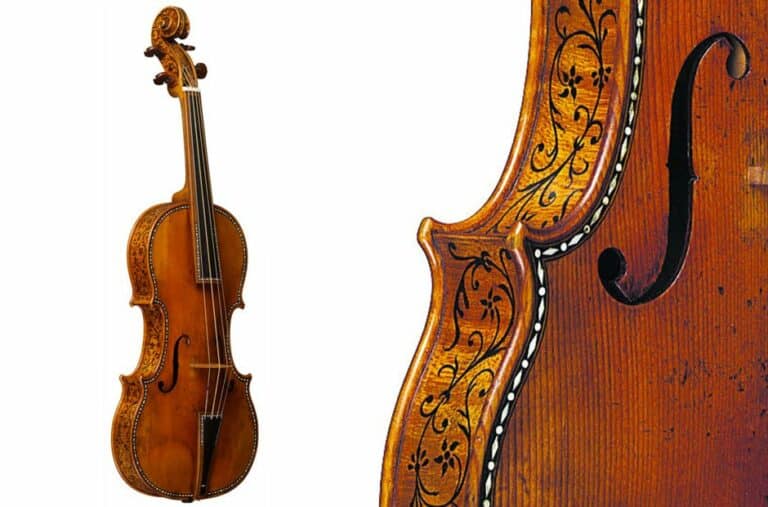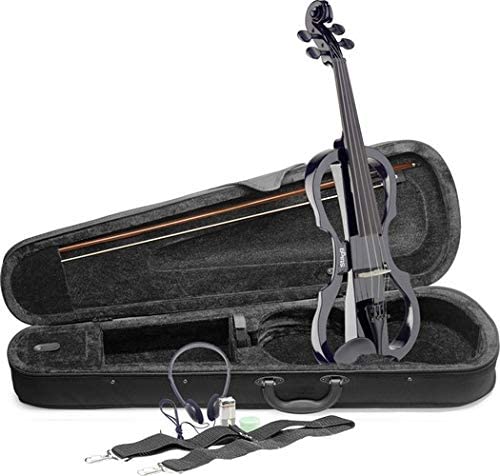How Does an Electric Violin Work?
Everyone knows the sound of a violin, whether from a classical concert or, more likely, from film soundtracks. On the other hand, electric guitars are pretty well-known. But electric violins? It is rare to go to a concert and hear an electric violin.
How do electric violins work? The bow vibrates the strings. That vibration is transferred to the wood and a piezo microphone pickup that transforms it into an electric signal. It is pre-amplified through an embedded electronic board or outputted directly to a mixing console.
The bow makes the sound the same type of strings
The way an electric violin produces its sound starts with the strings. Then, there is not much to say, except that:
- electric violins use the same type of bows as acoustic ones,
- electric violins use the same type of strings as acoustic violins.
So the core part of how the electric violin works is the same as with acoustic violins.
From the nut, to the tailpiece, the string vibrates the same way. At the same angle and onto the same type of bridge. If you want to read about how the sound is produced on a violin, I have described it extensively in a long blog post. This is out of scope here.
But now that we understand that the fundamentals are the same between an electric violin and an acoustic one let’s see how they differ and how the electric violin works.
An electric violin has no sounding box but a solid body construction
The more critical innovation when it comes to electric instruments (as opposed to electro-acoustic ones) is using a solid-body instrument.
That means that the wood is plain, without any cavity that would allow the wood to vibrate and amplify.
So, there is no way the violin can be heard more than a couple of feet away. A classical violin has been created to speak loud and to project far. On the contrary, solid-body instruments have been designed to be amplified.
When you want to amplify an instrument, a natural sounding box is something you do not wish to. It messes up with the microphone and the speakers. A sounding box amplifies the loudspeakers’ sound and gives it back to its attached microphone. This phenomenon is called: feedback.
That is why electric guitars have been created. With a heavy log of wood, Les Paul invented the first electric guitar. The dense wood gives a natural colorful vibration with great sustain. It doesn’t sound artificial. Unplugged, you can’t hear much of an electric instrument; but it can be loud without feedback or Larsen once plugged in.
That is the whole point of electric instruments: playing loud with big bands or sound systems and get a consistent sound.
But when Yamaha created its electric violin, it emphasized its ability to play silently, on the contrary. They didn’t see a market big enough for loud rock violin players. I can understand that. But instead, they directed it to any violinist who wants to practice in silence. They can even impress friends with one. You could still plug your instrument occasionally, which I did, and play gigs.
How do microphones work for electric instruments?
As an electric violin is designed not to have a natural sounding box, it needs another way to amplify the sound.
| Type of microphone | How they work | Advantage | Drawbacks |
|---|---|---|---|
| Piezo | Amplifies wood vibrations | Works with nylon, gut, and synthetic strings, no feedback | Not the best tone |
| Electric | Amplifies steel strings magnetic field | Can be loud, no feedback | Can’t amplify nylon, gut, nor synthetic strings |
| Regular microphone | Amplifies air vibrations | Best type of sound, adapts to any instrument | Can’t be amplified loud, picks up any room sound, feedback, needs a sounding box |
Piezo microphones
Piezo microphones are a great way to amplify the sound for instruments that have nylon or synthetic strings. These microphones have been around since the 19th century and are robust and straightforward.
The way they work is quite simple: they take advantage of a physic principle that a crystal produces a small amount of electricity when it gets compressed (source). In the case of electric violins, a crystal is glued under the bridge or in the bridge, as in the best ones. This crystal converts the vibrations into an electric current. This current is weak and needs to be amplified through a preamp embedded in the electronics of the violin.
Regular microphones
A regular microphone transforms the vibrations of the air (sound) into an electric current. The sound consists of waves in the air, that is to say, minor differences of pressure. A thin and light membrane vibrates with these waves. But this membrane is connected with an electromagnet that generates current when moving: that is how a standard microphone amplifies the sound. This electric current is weak and usually goes through a preamp first. Then, it is routed through a wire to a mixing console or a traditional amplifier.
The inconvenience of a regular microphone for an instrument is that it tends to amplify other instruments and background noise. That is why it is not the route usually taken to amplify an electric instrument. As it needs a sound (as opposed to simple wood vibrations) to amplify, a microphone is usually used in conjunction with an acoustic instrument: this is how an electro-acoustic instrument is designed. The advantage is maybe a better tone with richer harmonics and type of sound. But it can’t be amplified very loud and is very prone to feedback and a loop.
Electric microphones
Electric microphones are the type of microphones used to amplify electric guitars. Now, they can be used to amplify other types of string-instruments as well.
They need steel strings because they amplify the vibration of the string itself.
As the piezo amplifies the pressure, the microphone the air, the electric microphone amplifies the change in the magnetic field created by the motion of a steel string close to a magnet.
The vibrating steel string creates a magnetic field that varies according to its force and wavelength. The microphone consists of a magnet that uses the following physic law.
A wire is winded around a magnet. The magnet responds to the steel string by creating a magnetic field. This magnetic field is transformed into an electric current by the wire.
That is how an electric motor and turbine work, by the way. So this weak current needs again a pre-amplification that usually occurs in the instrument.
As the steel strings that vibrate create a magnetic field in the microphone, there is no need for a soundbox, and this technology works great for solid-body electric instruments. The advantage is that the violin can be amplified loud, and there is no risk of feedback. But the sound is not comparable to an acoustic violin. These types of microphones are not used much for electric violins.
Embedded electronics in electric violins
Pre-amplification
As we’ve seen, microphones do not create an intense current, and the signal is weak. So it needs to be amplified a first time close to the source. That is the role of a preamp. It can be called an active microphone (as opposed to a passive one).
For example, the Yamaha electric violin YEV-105 has a passive output (without preamp). An electronic circuit board allows to adjust the volume and can be bypassed. In that case, we can get the raw bridge piezo-microphone output, which gives a great tone and dynamic range to a preamp.
The YSV104 and SV250 have a proprietary output to a control box that provides energy to an included preamp. The piezo-microphone is then pre-amplified in the control box. It can be called an active electronic system. The control box provides additional functionalities such as aux in, reverb, tone, line out, headphones.
Now that the signal is pre-amplified, it can be modified, adjusted and blended with the embedded electronic circuit that provides:
- Tone control and equalization. The sound can be adjusted just after the preamp. Some musicians prefer to get a raw sound and adjust it later on the mixing table. But you get that choice if you are plugged into your own amplifier.
- Auxiliaries. Aux in provides an additional benefit to those who practice with their violin at home. You can route through your violin any input source. That means you can plug an iPod, any play along, and play on top of that. The benefit is to get the resulting sound blended in your headphones. You can adjust the input sound with a knob on the SV-100 series.
- Effects. Again, unless you will mix your sound later and prefer a raw sound, your Yamaha electric violin will give you the ability to play with some reverb. Playing on a solid body instrument with a piezo microphone deprives you of the natural resonance of the room you play in. The sound is really dry. It as if you eat without any salt. So some reverb is always good. Yamaha violins offer three presets: room, hall 1, hall 2. Room is the bare minimum reverb to play with. Hall 1 and 2 give the impression you play in a big hall.
- Headphones. It is a pre-amplified output to plug headphones into. The impedance is suitable for headphones, and you will get your effects in that output (and the mix with the aux in input). This output is stereo, mini-jack.
- Line out. It is a direct passive output that needs to be amplified. It is a mini-jack mono-output or regular jack for the SV250 and YEV104.
What is the type of sound of electric violins?
The source of sound is eternal: the vibration of a string with a bow. But the resulted sound is never the same. With a solid body, an electric violin depends on the type of microphone pickup and electronics to produce a good sound. A piezo pickup is straightforward and sturdy but can sound a bit dry. It is perfect for a rock or a modern sound. Some electric violins, or even electro-acoustic ones, try to offer the best of both worlds and sound like an acoustic, classical violin. They can sometimes be close. But the sound of an electric violin shouldn’t be just to copy an acoustic one. It can be appreciated for itself.
The gear and products I use and recommend for my electric violin
First, If you want to hear your electric violin, you need to either use headphones, plug it into an amp, or an audio interface.
The small amp I use and recommend if you want to practice at home is the great Yamaha THR10 from the THR series. It is portable and not expensive, easy to use and set up.
If you want to record yourself or plug your violin into headphones, your laptop, or your phone, a good and cheap digital audio interface I can recommend is the iRig HD2, which is more and more affordable on Amazon.
I typically use Thomastik Dominant strings on my electric violin. They come quite cheap on Amazon considering their quality and sound. Synthetic core strings work well on Yamaha electric violins.
Lastly, I use mainly Dominant rosin as well on my electric violin, as it has been designed to go with Dominant Strings.
You can check out in detail all the stuff I have tested and used on my recommended product page where I go into more details.






